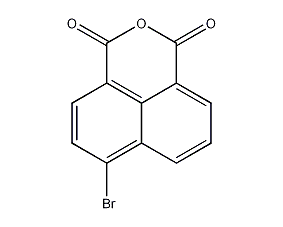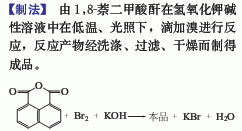
Structural formula
| Business number | 01SH |
|---|---|
| Molecular formula | C12H5BrO3 |
| Molecular weight | 277.07 |
| label |
Aromatic carboxylic acids and their derivatives |
Numbering system
CAS number:81-86-7
MDL number:MFCD00006927
EINECS number:201-382-3
RTECS number:None
BRN number:None
PubChem number:24859432
Physical property data
1. Properties: white or off-white loose crystalline powder.
2. Density (g/mL, 25/4℃): Uncertain
3. Relative vapor density (g/mL, air=1): Uncertain
4. Melting point (ºC):): 220
5. Boiling point (ºC, normal pressure): Uncertain
6. Boiling point (ºC, 5.2kPa): Uncertain
7. Refractive index: Uncertain
8. Flash point (ºC): Uncertain
9. Specific rotation (º): Uncertain Determined
10. Autoignition point or ignition temperature (ºC): Uncertain
11. Vapor pressure (kPa, 25ºC): Uncertain
12. Saturated vapor pressure (kPa, 60ºC): Uncertain
13. Heat of combustion (KJ/mol): Uncertain
14. Critical temperature (ºC): Uncertain
15. Critical pressure (KPa): Uncertain
16. Log value of oil-water (octanol/water) partition coefficient: Uncertain
17. Explosion upper limit ( %, V/V): Uncertain
18. Lower explosion limit (%, V/V): Uncertain
19. Solubility: Insoluble in water and dilute acid, soluble It becomes sodium salt in dilute alkali solution, soluble in concentrated nitric acid, and slightly soluble in organic solvents (such as glacial acetic acid, chlorobenzene, dimethylformamide, ethylene glycol, methyl ether, etc.).
Toxicological data
None yet
Ecological data
None yet
Molecular structure data
1. Molar refractive index: 61.21
2. Molar volume (cm3/mol): 152.8
3. Isotonic specific volume (90.2K ): 439.0
4. Surface tension (dyne/cm): 68.0
5. Polarizability (10-24cm3): 24.26
Compute chemical data
1. Reference value for hydrophobic parameter calculation (XlogP): 3.2
2. Number of hydrogen bond donors: 0
3. Number of hydrogen bond acceptors: 3
4. Number of rotatable chemical bonds: 0
5. Number of tautomers: none
6. Topological molecule polar surface area 43.4
7. Number of heavy atoms: 16
8. Surface charge: 0
9. Complexity: 341
10. Number of isotope atoms: 0
11. Determined number of atomic stereocenters: 0
12. Uncertain number of atomic stereocenters: 0
13. Determine the number of stereocenters of chemical bonds: 0
14. Uncertain number of stereocenters of chemical bonds: 0
15. Number of covalent bond units: 1
Properties and stability
This product is toxic and highly irritating to the skin. When in contact with the skin, it can cause skin diseases such as dermatitis, pustules, pigmentation, keratosis, and sebaceous gland blockage. This inflammation can also develop deep into the skin and leave scars, making treatment difficult. Therefore, production equipment should be sealed to prevent leakage, ventilation should be strengthened, and operators should wear protective equipment.
Storage method
Stored sealed and protected from light.
Package tightly in wooden barrels or iron barrels lined with plastic bags. The left mark is marked with “poisonous” items. Store and transport according to toxic substance regulations.
Synthesis method

Purpose
Dye intermediates. Mainly used to prepare fluorescent yellow, fluorescent orange and other dyes. It is also an important intermediate for fluorescent whitening agents.

 微信扫一扫打赏
微信扫一扫打赏

